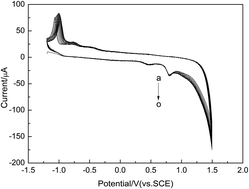A voltammetric sensor based on eosin Y film modified glassy carbon electrode for simultaneous determination of hydroquinone and catechol
Abstract
By using cyclic voltammetry, eosin Y film was electrodeposited on the surface of glassy carbon electrode (GCE) to obtain the modified electrode (denoted as eosin Y/GCE). Scanning electron microscopy, electrochemical impedance spectroscopy and cyclic voltammetry techniques were used for the characterization of the morphological and electrochemical properties of eosin Y/GCE. The electrocatalysis capability of eosin Y/GCE to hydroquinone (HQ) and catechol (CC) was investigated by cyclic voltammetry (CV) and differential pulse voltammetry (DPV) techniques. Compared with the bare GCE, eosin Y/GCE exhibited outstanding electrocatalytic activity and reversibility towards the oxidation of HQ and CC. The oxidation and reduction peak separation was decreased from 386 to 60 mV for HQ and from 340 to 56 mV for CC at eosin Y/GCE. The differential pulse voltammetry results showed that the oxidation peaks of the two isomers in acetate buffer solution could be clearly discriminated with a peak potential separation of ca. 106 mV, which was sufficiently wide to discriminate the two dihydroxybenzene isomers. Under optimal conditions, the oxidation peak currents were linear to HQ/CC concentration in the range from 1 μM to 130 μM with a detection limit of 0.14 μM (3σ) for HQ and 0.12 μM (3σ) for CC. Moreover, eosin Y/GCE exhibited excellent anti-interference ability, and was successfully applied to the simultaneous determination of HQ and CC in spiked water samples with reliable recovery.


 Please wait while we load your content...
Please wait while we load your content...